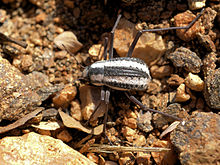Stenocara gracilipes
| Stenocara gracilipes | |
|---|---|

| |
| Scientific classification | |
| Domain: | Eukaryota |
| Kingdom: | Animalia |
| Phylum: | Arthropoda |
| Class: | Insecta |
| Order: | Coleoptera |
| Family: | Tenebrionidae |
| Genus: | Stenocara |
| Species: | S. gracilipes
|
| Binomial name | |
| Stenocara gracilipes Solier, 1835
| |
Stenocara gracilipes is a species of beetle that is native to the Namib Desert in southern Africa. This is one of the most arid areas of the world, receiving only 1.4 centimetres (0.55 in) of rain per year. The beetle is able to survive by collecting water on its bumpy back surface from early morning fogs.
To drink water, the S. gracilipes stands on a small ridge of sand using its long, spindly legs. Facing into the breeze, with its body angled at 45°, the beetle catches fog droplets on its hardened wings, or elytra. Its head faces upwind, and its stiff, bumpy elytra are spread against the damp breeze. Minute water droplets (15-20 μm in diameter) from the fog gather on its wings; there the droplets stick to hydrophilic (water-loving) bumps, which are surrounded by waxy, hydrophobic troughs. Droplets flatten as they make contact with the hydrophilic surfaces, preventing them from being blown by wind and providing a surface for other droplets to attach. Accumulation continues until the combined droplet weight overcomes the water's electrostatic attraction to the bumps as well as any opposing force of the wind; in a 30 km/h breeze, such a droplet would stick to the wing until it grows to roughly 5 mm in diameter; at that point it will roll down the beetle's back to its mouthparts.
Researchers at the Massachusetts Institute of Technology have emulated this capability by creating a textured surface that combines alternating hydrophobic and hydrophilic materials. Potential uses include extracting moisture from the air[1] and creating fog-free windows and mirrors. A company called NBD Nano is attempting to commercialize the technology.[2][3][needs update]
Recently, it has been shown that these beetles may also obtain water from dew (i.e. from humid air without fog).[4][5]
See also
[edit]- Onymacris unguicularis, another fog-basking Namib desert beetle
- Physosterna cribripes, another fog-basking Namib desert beetle
References
[edit]- ^ Airdrop Irrigation at gizmag. Retrieved 2015-01-05.
- ^ "Official NBD homepage". Retrieved 2012-10-29.
- ^ "Namib Desert beetle inspires self-filling water bottle". BBC News. 2012-11-23.
- ^ Springer Corporate Communications (8 December 2014). "Biomimetic dew harvesters". Springer. Retrieved 3 February 2022.
- ^ de la Giroday, Maryse (December 2014). "Do Tenebrionind beetles collect dew or condensation—a water issue at the nanoscale". FrogHeart Communications. Retrieved 20 January 2015.
Further reading
[edit]- Parker, A. R. & C. R. Lawrence (2001). "Water capture by a desert beetle". Nature. 414 (6859): 33–34. doi:10.1038/35102108. PMID 11689930. S2CID 34785113.
- Guadarrama-Cetina, J.M.; et al. (2014). "Dew condensation on desert beetle skin". Eur. Phys. J. E. 37 (11): 109. doi:10.1140/epje/i2014-14109-y. hdl:10171/37082. PMID 25403836. S2CID 21054231.
- Harries-Rees, Karen (August 31, 2005). "Desert beetle provides model for fog-free nanocoating". Chemistry World News. Royal Society of Chemistry.
- "Stenocara beetle". Biomimicry Guild. Archived from the original on 2006-12-08. Retrieved 2006-12-14.
